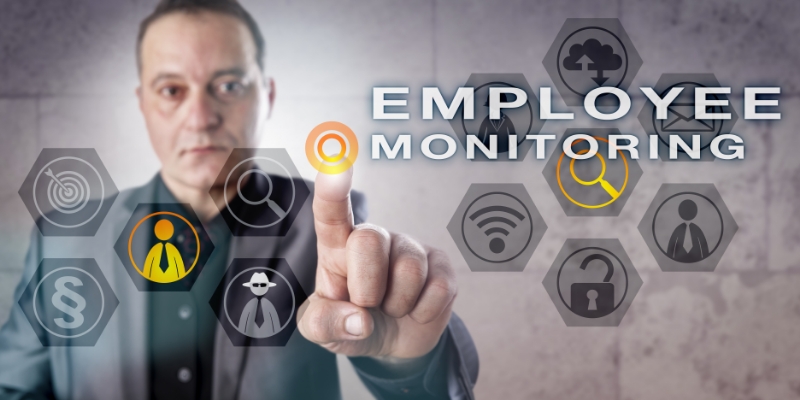
Employee monitoring is here to stay.Gone are the days when employees reported for work at an office and stayed there until the end of the day. It’s been several years since remote and hybrid working became the new norm.
Such work conveniences raise several questions for employers: How can they monitor on-site, remote, or hybrid employees? How to monitor employee behavior, cyber security, task completion, and time management?
The truth is employee monitoring stretches beyond mere tracking and analysis. It has transformed into a factor that influences employee engagement and productivity. How? Let’s delve into the details.
Of late, so much is being said about “productivity”- a word that seems omnipresent. What is productivity?
Productivity is considered one of the most critical drivers of economic growth and competitiveness. Moreover, it is the fundamental parameter for measuring the performance of everything: the company, employers, staff, workplace, products, and services.
At the workforce level, employee productivity monitoring is a practice embraced by organizations to ascertain their employees’ work engagement and contribution daily, hourly, or minute-by-minute.
Basically, the term “employee productivity monitoring” encompasses several aspects, such as:
So, why should employee productivity be monitored?
Compared with times when employee monitoring was frowned upon, we have come a long way. Employee productivity monitoring doesn't stop with surveillance and collecting employee information. It is a practice that helps:
With so much going on, employees are more likely to focus on their work if they know that management monitors their performance, behaviors, and how they spend their time.
But how does employee productivity management work? How is it implemented and brought into practice? Thinking about doing it manually? In this digital age, monitoring employee productivity the old-fashioned way is time-consuming, inefficient, and painstaking.
So, what is the solution?
Employee productivity tracking software is the most convenient and effective way to track employee productivity.
It's true that employee tracking software involves device monitoring, but the company as a whole will benefit from the resulting analysis.
Employee monitoring software can provide you with detailed information on an employee's daily productivity metrics, whether they are working in the office or remotely. The majority of employee monitoring software is designed to track:
The current digital scenario offers a plethora of highly upgraded monitoring software packed with a wide range of features required for particular industries and organizational setups.
However, when it comes to productivity monitoring, most software offers the following features:
1. Network Surveillance
To track the network traffic used in your organization and detect malicious activity that threatens your data security.
2. Video surveillance
To keep a look out for employee misconduct, theft, or unsavory incidents in the workplace. Although many organizations do not prefer video surveillance, it may be mandatory for some businesses for safety reasons.
3. Email Surveillance
Employees should remember not to use work email for personal purposes. Organizations use email monitoring software to check if employees adhere to this rule and prevent misusing official emails.
4. Screenshots
Although employers can monitor their employees directly through web cameras, taking random screenshots of their devices is more efficient and less intrusive. Screen capturing software enables managers to see screenshots of their team members' progress to ensure they are on the right track.
Dedicated Employee Productivity Monitoring Software
Rather than using different software for various monitoring tasks, using a single, specialized tool to unify your entire workforce and their work processes would be more sensible. Real-time metrics from this software can give you an accurate picture of how your employees spend their time at work, how they use the internet, and how they communicate with each other. It reports their idle and active periods and allows managers to view screenshots of workers' computer activities.
Besides these advantages, how else does a specialized employee monitoring tool benefit you? Let’s check it out.
1. Actual Workflow Analysis
Nothing gives you an accurate analysis of your employee’s performance metrics like a specialized productivity monitoring tool. This single tool gives you a comprehensive view of your team’s efficiency. With this vital intelligence, your organization can modify its organizational structure in real time to suit each employee, no matter where they work.
2. Efficiency Resource & Time Management
Keeping track of employee productivity saves the company considerable money by tracking resource usage and activities. Reallocating resources and improving efficiency can be achieved with employee monitoring software.
3. Upgraded Productivity Measures
Using employee monitoring tools, you can track the hours an employee worked daily on the given tasks. You can make informed decisions based on the productivity rates of the individual, the team, and the entire firm. To promote a competitive spirit among your employees, you can give each one a productivity score to target.
4. Recognize Efficient Employees
Thanks to the transparency of monitoring, it becomes easier to recognize and reward employees who excel at productivity. Using the productivity tool, you can boost employee morale and encourage those facing roadblocks to achieving their goals.
An employee productivity monitoring system is a win-win situation for employers and employees. It is an effective practice that delivers long-term benefits for every organization.
No matter where they work, a sophisticated employee productivity tracker like More/hour can help you keep track of their productivity. Want to know more about our software? Call us today.